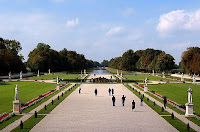The Nymphenburg Palace is a Baroque palace in Munich, Bavaria, Germany is a famous tourist aattraction and travel destination site. The palace was the main summer residence of the rulers of Bavaria. It is also called as Nymph's Castle. More details of Nymphenburg Palace is explained in world tour guides below. The palace was commissioned by the prince-electoral couple Ferdinand Maria and Henriette Adelaide of Savoy to the designs of the Italian architect Agostino Barelli in 1664 after the birth of their son Maximilian II Emanuel. The central pavilion was completed in 1675.
 Starting in 1701, Max Emanuel, the heir to Bavaria, a souvereign electorate of the Holy Roman Empire, conducted a systematic extension of the palace. Two pavilions were added each in the south and north of Barelli's palace by Enrico Zucalli and Giovanni Antonio Viscardi. Later the south section of the palace was further extended to form the court stables. As a balance the orangerie was added to the north. Finally a grand circle the Schlossrondell with baroque mansions the so called Kavaliershauschen cavaliers lodges was erected under Max Emanuel's son Holy Roman Emperor Charles VII Albert.
Starting in 1701, Max Emanuel, the heir to Bavaria, a souvereign electorate of the Holy Roman Empire, conducted a systematic extension of the palace. Two pavilions were added each in the south and north of Barelli's palace by Enrico Zucalli and Giovanni Antonio Viscardi. Later the south section of the palace was further extended to form the court stables. As a balance the orangerie was added to the north. Finally a grand circle the Schlossrondell with baroque mansions the so called Kavaliershauschen cavaliers lodges was erected under Max Emanuel's son Holy Roman Emperor Charles VII Albert.Joseph Effner redesigned the facade of the center pavilion in French baroque style with pilasters in 1716. In 1826 Leo von Klenze removed its gables with the electoral coat of arms and created an attic decoration directly under the roof instead. With the Treaty of Nymphenburg concluded in July 1741, Charles Albert allied with France and Spain against Austria. For a long time, the palace was the favourite summer residence of the rulers of Bavaria. King Max I Joseph died there in 1825, and his great-grandson King Ludwig II was born there in 1845.
Today, Nymphenburg is open to the public, but also continues to be a home and chancery for the head of the house of Wittelsbach, currently Franz, Duke of Bavaria. palace, together with its park, is now one of the most famous sights of Munich. The baroque facades comprise an overall with of about 700 metres. The Steinerner Saal or Stone Hall, with ceiling frescoes by Johann Baptist Zimmermann and F. Zimmermann and decorations by François de Cuvillies, is an impressive sight. Acting as a grand hall, it occupies over three floors of the central pavilion of the palace. Some rooms still show their original baroque decoration while others were later redesigned in rococo or neoclassical style. The former small dining room in the south pavilion today houses the Gallery of Beauties of King Ludwig I of Bavaria. This pavilion houses also the birthroom of King Ludwig II of Bavaria.

 The 200-hectare or 490-acre park, once an Italian garden in 1671, which was enlarged and rearranged in French style by Dominique Girard, a pupil of Le Notre, was finally redone in the English manner in early 19th century by Friedrich Ludwig von Sckell, on behalf of prince-elector Karl-Theodor also the creator of the English Garden, Munich's green lung, bigger than Central Park and probably one of the worlds biggest inner city parks. He preserved the main elements of the Baroque garden. The park is bisected by a long canal along the principle axis which leads from the palace to the marble cascade in the west. Two lakes are situated on both sides of the canal. The Dorfchen was created under Maximilian III Joseph as Petit hameau. The Salettl a cottage with its little garden nearby close to the former menagerie served as attraction for the children of Maximilian IV Joseph.
The 200-hectare or 490-acre park, once an Italian garden in 1671, which was enlarged and rearranged in French style by Dominique Girard, a pupil of Le Notre, was finally redone in the English manner in early 19th century by Friedrich Ludwig von Sckell, on behalf of prince-elector Karl-Theodor also the creator of the English Garden, Munich's green lung, bigger than Central Park and probably one of the worlds biggest inner city parks. He preserved the main elements of the Baroque garden. The park is bisected by a long canal along the principle axis which leads from the palace to the marble cascade in the west. Two lakes are situated on both sides of the canal. The Dorfchen was created under Maximilian III Joseph as Petit hameau. The Salettl a cottage with its little garden nearby close to the former menagerie served as attraction for the children of Maximilian IV Joseph.The castle as well as the park are important economic factors for the city of Munich. The main building alone has more than 300,000 visitors per year. Nymphenburg Palace lies ahead the Munich Residence and Schleissheim Palace. It is possible to visit the palace by taking the tram number 17 towards Amalienburgstrasse. This line passes through the city centre, including Stachus and the main train station. It takes approximately 20 minutes to get from the city center to the palace by tram. The palace and its park were some of the main filming locations of Alain Resnais 1961 movie Last Year at Marienbad. The Dressage Facility for the equestrian events of the 1972 Summer Olympics was created in the Nymphenburg park.







No comments:
Post a Comment